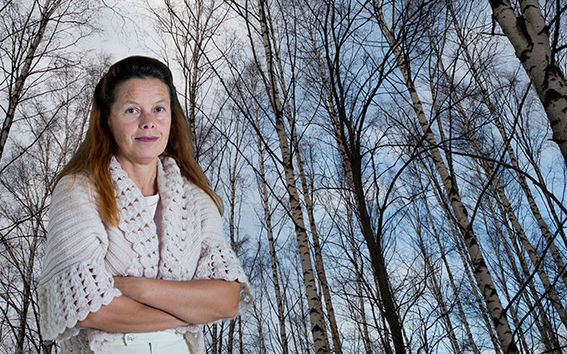Professor of Energy Technology and Energy Economics Sanna Syri focuses on mitigating climate change

Aalto University is a familiar seat of learning to Sanna Syri. She has been a professor at the Department of Energy Technology since 2010. She was appointed as a permanent professor in November.
Syri, who works at the university, feels that professorship is her vocation. Working with students is one of the advantages of the profession.
‘The most essential thing to me is to be able to work together with the students. Students who come here to study are very smart, motivated and nice young people. They share an interest in energy and the environment.’
Every year, Syri supervises nearly twenty students preparing their master’s theses. That way she gets to see matters from the point of view of companies and always learns something new herself.
Managing climate change
In her own research, Syri has focused on questions related to mitigation of climate change. She examines large-scale energy systems that cover an individual city, country, continent or the entire world.
Syri followed the climate meeting held in Paris at the beginning of December closely. The 195 countries that took part in the meeting unanimously accepted the agreement on mitigating global warming after 2020.
‘This agreement was a very important and good thing to happen. However, the promises made by countries to reduce emissions are not sufficient to limit warming to two degrees, let alone to the 1.5 degrees that was the target recorded.’
Syri sees the announcement made by China to halt the growth of its emissions by 2030 as a big step forward. However, as regards the development as a whole, it is not good that China can continue to increase its emissions for another 15 years.
‘The aim of the meeting was to agree on policy instruments which would help turn large energy systems less carbon-intensive than they are currently. It is essential that these policy instruments are cost-effective and have a positive effect on the energy markets. A big question is what kind of financing mechanisms would encourage developing countries to switch to cleaner technology.’
Difficult choices
Choices of energy production methods are essential in curbing climate change. Energy production accounts for 80 per cent of greenhouse gas emissions when transport fuels are included.
Decision-makers, citizens and even scientists have different views on how energy should be produced. During the past few years, solar and wind energy have raised optimistic expectations in Europe while the willingness to give up nuclear energy has been on the increase.
‘There are great passions and ideological views linked to energy choices. Understandably, people have different opinions, as there are many variables and forecasting the future is difficult,’ says Syri.
In Syri’s opinion, for the time being all emission-free techniques, including nuclear energy, are needed in energy production. Additionally, energy efficiency of all systems must be improved.
The difficulty with solar and wind power is the irregular electricity production that is dependent on wind speeds and hours of sunshine. Electricity should be stored, but the technology is expensive. It is not possible to build more hydroelectric power plants and the use of bioenergy is also limited.
‘Solar energy is a well suited solution for households and other end users to produce their own electricity. However, solar and wind energy cannot entirely replace nuclear power, which produces energy evenly around the year. At least not until we manage to develop competitive techniques for storing electricity. And that will still take time.’
Carbon dioxide capture could be one solution to reducing emissions. But in Europe, faith in possibilities provided by this technology has waned. The technology is still researched in North America, Australia and Asia. In Finland, the subject is studied at Aalto University and Åbo Akademi.
Syri reminds us that energy revolution needs to take place urgently. We should be able to turn all energy systems in the world emission-free in just over 30 years.
In Syri’s opinion, emission trade would be a perfect instrument for steering energy choices. However, the mechanism has not been working in the desired way for a long time now.
‘Fortunately, the European Commission strives to mend the weaknesses in the emissions trade. The Commission is also aware of the problems caused in the electricity markets by the generous aid policy directed to solar and wind electricity.
Therefore, we can hope that at least problems in the emissions trade will gradually be a thing of the past.’
Studying in an international environment
About 45 Masters of Science in Technology graduate from the Department of Energy Technology at the Aalto University School of Engineering every year. About one third of them study Energy Technology and Energy Economics. The Masters Programme in Energy Technology starts in 2016.
‘The field is really popular. So far, students have found employment fairly well. Apart from the past year, it has also been easy to find subjects for master’s theses. The economic downturn has now started to affect studies in higher education institutions.’
Graduates can expect to find versatile work. Work is offered, for example, by large energy companies, technology companies developing the energy efficiency of their own products, small consulting companies and the authorities.
About one quarter of students and post-graduate students are foreign, which Syri finds good. That way it is possible to find natural ways to use examples from energy systems and energy policies in different countries and compare them in the studies.
‘Finnish students are also keen to take part in exchange programmes abroad. The field is international.’
- Published:
- Updated:
Read more news

Aalto ARTS alum Vidha Samya’s artwork featured at the Venice Biennale 2024
The Pavilion of Finland presents ‘The pleasures we choose’ at the 60th International Art Exhibition – La Biennale di Venezia until 24 November 2024.
IoT Forge donates EUR 1 million to the School of Engineering
The donation will be used for research and education on the Industrial Internet and digital twins.
Join us for the first Aalto Open Science Award Ceremony
All Aaltonians are welcome – no registration required!